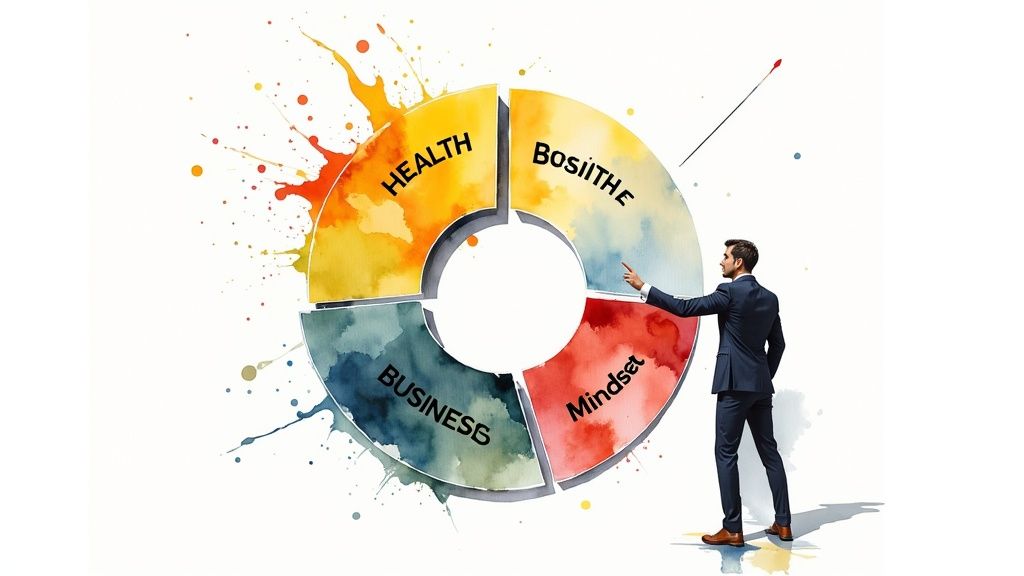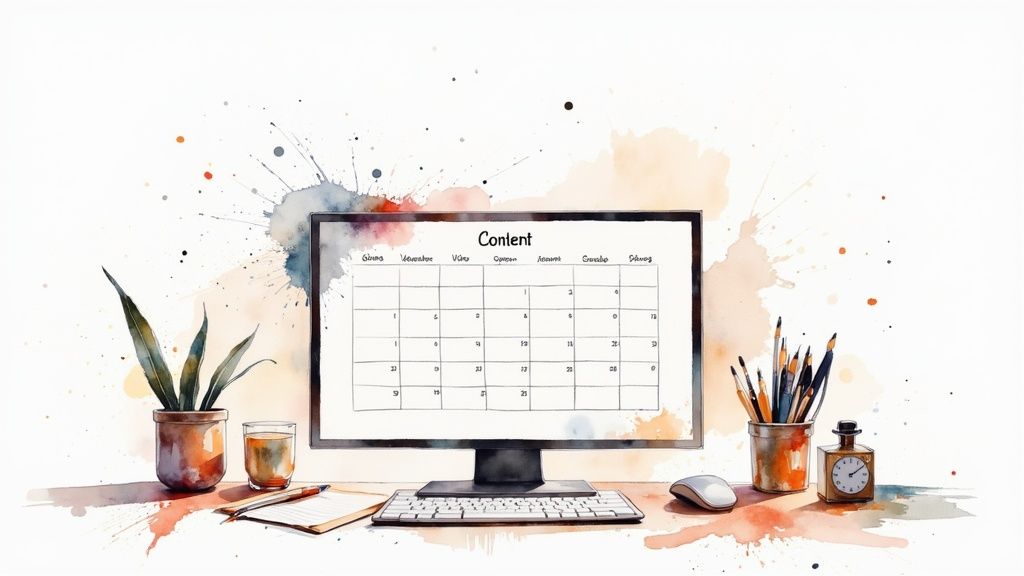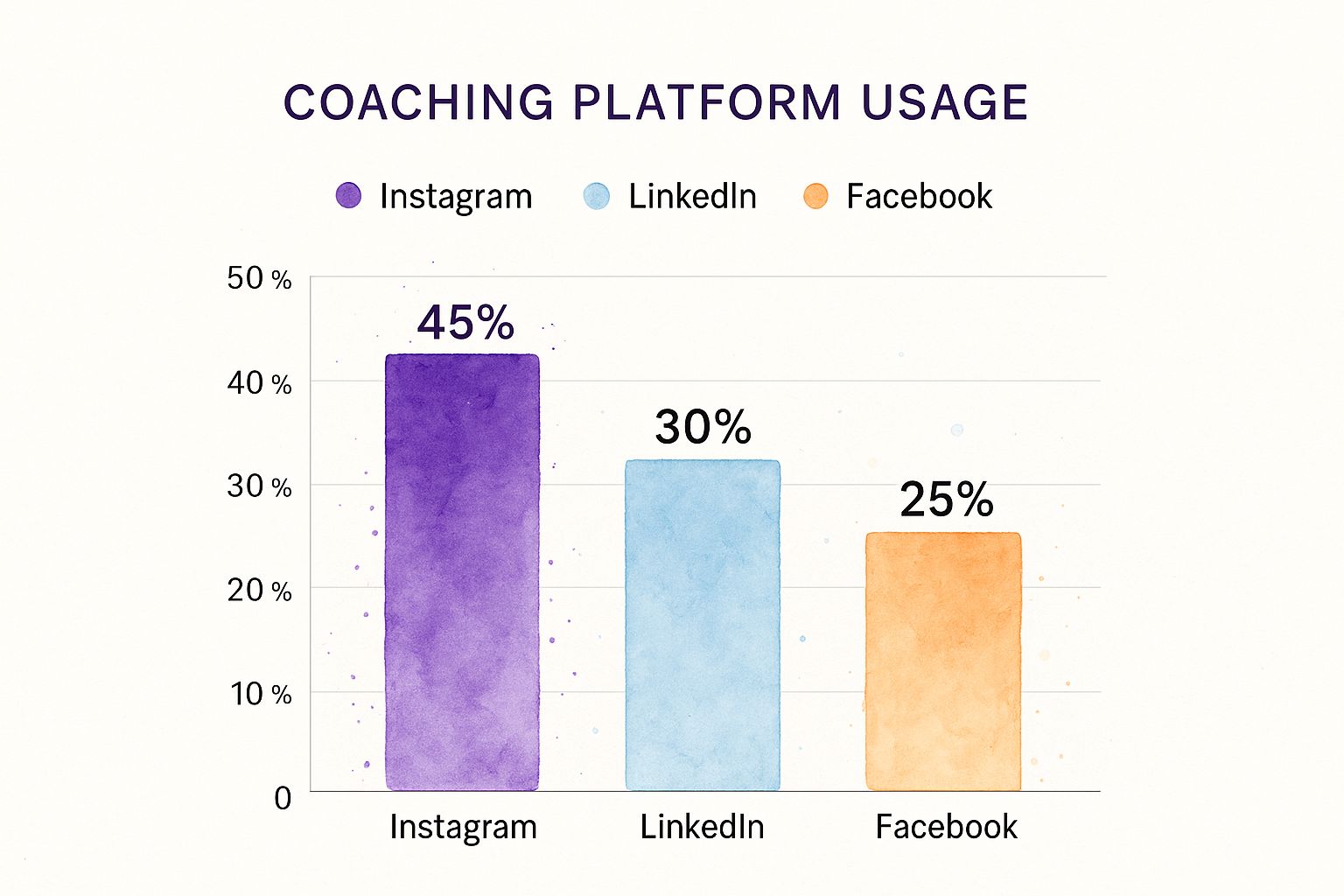Marketing for Coaches: The Definitive Guide to Getting Clients in 2024

Effective marketing for coaches isn’t about chasing every trend or posting on social media 24/7. It’s about building a predictable system that attracts the right clients, proves your value, and positions you as the go-to expert in your niche. Forget the overwhelm of juggling a dozen tools and strategies. This guide will give you a proven, step-by-step framework to build a coaching business that not only gets clients but also gives you your time back.
You don’t need to be everywhere. You need a rock-solid foundation, a smart content strategy, and the right systems to make it all run smoothly. Do that, and high-ticket clients will stop being a goal and start being an expectation.
Building Your Marketing Foundation

Before you spend a dime on ads or an hour creating content, your success hinges on one thing: absolute clarity. I’ve seen countless talented coaches burn out because they tried to help everyone. Vague titles like "life coach" or "business coach" are so broad they become invisible in a sea of sameness.
The coaching industry is massive—it's on track to become a $7.31 billion market by 2025. With the number of certified coaches globally expected to blow past 145,000, blending in is a death sentence for your business. Standing out isn't just a good idea; it's the only way to survive.
Your first job is to build that unshakable foundation. This isn’t about picking a fancy label. It’s about owning the specific, tangible problem you solve for a very specific type of person.
Finding Your Profitable Niche
Think of your niche as a magnet. It pulls in your perfect-fit clients and actively pushes away those who would waste your time and energy. Suddenly, every piece of marketing you create becomes exponentially more powerful. You’re no longer shouting into a crowded stadium; you’re having an intimate conversation with someone who feels like you’re reading their mind.
Let’s get specific. Here are a few real-world examples:
- Don't be a "Career Coach." Instead, be the go-to coach who helps first-generation tech employees navigate corporate politics to land their first management role.
- Don't be a "Wellness Coach." Instead, be the expert who helps burnt-out ER nurses build self-care routines that actually work with their grueling 12-hour shifts.
- Don't be a "Relationship Coach." Instead, be the specialist who guides entrepreneurial couples through the financial and emotional maze of merging their businesses after getting married.
Key Takeaway: Don't be a jack-of-all-trades. Become the undisputed expert for a specific group of people. When you solve a painful, high-value problem, clients don't just find you—they hunt you down and are happy to pay a premium.
Defining Your Unique Value Proposition
Once you've zeroed in on your niche, you need to nail down your Unique Value Proposition (UVP). This is a simple, clear statement that tells people exactly what you do, who you do it for, and why you're the best person for the job.
A great starting formula is: "I help [Specific Audience] achieve [Specific Outcome] by [Your Unique Method]."
For instance: "I help first-time authors crush writer's block and finish their manuscript in 90 days using my 'Story Sprint' framework."
See how powerful that is? It immediately communicates your value and sets you apart from every other writing coach. This UVP becomes the heart of your website copy, your social media bio, and every marketing message you send.
Getting these foundational pieces right informs every other marketing decision you'll make. For those just setting up shop online, this guide on how to promote a new site is a goldmine for getting started on the right foot. With a sharp niche and a compelling UVP, your marketing will finally have the direction and punch it needs to succeed.
Creating Content That Attracts Coaching Clients

With your foundation solidly in place, it's time to build the engine of your marketing machine: your content. This is how you build trust and showcase your expertise long before anyone ever pays you. Aimless posting is a fast track to burnout. The goal is to create a strategic content ecosystem that positions you as the undeniable expert.
This all starts with a powerful mindset shift: create once, distribute forever.
Develop Your Pillar Content
Your pillar content is the cornerstone of your entire marketing strategy. It’s a substantial, in-depth piece of content that tackles a major pain point for your ideal client head-on. It's your definitive guide on a core topic.
This isn't just another blog post. It's a high-value asset with a long shelf life.
Here are a few actionable examples:
- The Ultimate Guide: A comprehensive blog post (2,000+ words) like, "The Ultimate Guide to Overcoming Imposter Syndrome for New Female Executives."
- A Foundational Webinar: A one-hour deep-dive presentation walking your audience through a specific framework you’ve developed.
- A Multi-Day Email Challenge: A series of automated emails guiding subscribers through a tangible transformation over three to five days.
The magic is that your pillar content isn't a one-and-done effort. It’s a wellspring of smaller content pieces you can repurpose for months.
Key Takeaway: Your marketing becomes exponentially easier when you stop thinking in terms of daily content creation and start thinking in terms of strategic content repurposing. One pillar piece can fuel an entire month's marketing calendar.
Repurpose Everything Strategically
Once your pillar piece is done, atomize it—break it down into bite-sized "micro-content" and share it across the platforms where your audience hangs out.
Let's stick with our webinar example, "Overcoming Imposter Syndrome for New Female Executives." Here’s how you could repurpose it:
- Short-Form Video: Pull five key one-minute insights and turn them into Instagram Reels or TikTok videos.
- LinkedIn Carousel: Convert the main presentation slides into a visually engaging carousel post summarizing your core framework.
- Blog Posts: Transcribe the webinar and split it into three separate, SEO-optimized blog posts.
- Email Newsletter: Send a weekly email sharing one key takeaway from the webinar with a personal story.
- Quote Graphics: Design 10-15 graphics with powerful quotes from your talk to share on social media.
This approach creates a cohesive content ecosystem. Someone sees a Reel, which leads them to your webinar, which gets them on your email list. Every piece reinforces your expertise and nudges them closer to becoming a client.
Choose Your Battlefield Wisely
You don't need to be everywhere. You only need to be where your clients are. An executive coach trying to build a following on TikTok is wasting energy. A wellness coach for new moms who ignores Instagram is missing a massive opportunity.
- For B2B or Corporate Coaches (Executive, Career, Leadership): LinkedIn is your home base. Focus on insightful text posts, articles, and carousels.
- For B2C or Visually-Driven Niches (Wellness, Fitness, Life): Instagram is your best bet. Go all-in on Reels, Stories, and high-quality visuals.
- For Niches That Thrive on Community: Facebook Groups can be a goldmine. Start your own group or become a valuable voice in existing ones.
No matter where you post, the goal is always to move people off "rented land" (social media) and onto property you own—like your email list or a dedicated community. This is where a platform like Zanfia becomes the strategic solution. Its integrated platform lets you bring your content, courses, and community all under one roof, creating a central hub for your business instead of chaotic, disconnected tools. Explore the benefits of a community platform for creators to see how this works.
For a deeper dive into crafting your message, check out this guide on developing a robust content marketing strategy.
Build a Community Around Your Coaching Brand

Great content pulls in an audience, but a community transforms followers into a loyal tribe. One-on-one coaching is limited by your time. A community, however, is a scalable asset that becomes an incredible marketing engine for your business.
Your best marketing will always come from client success. A community is where those successes are shared, celebrated, and multiplied. It’s where clients support each other and become your most passionate advocates. This isn’t just about retention; it’s about creating a powerful network effect that fuels itself.
When members feel a true sense of belonging, they are far more likely to stay engaged, invest in higher-level programs, and bring new clients into your world.
Where Should Your Community Live?
The platform you choose shapes the culture of your group. The goal is to create a space that feels exclusive, valuable, and simple for your members to use.
You have two main paths:
- Free, Public Platforms: Think Facebook Groups or LinkedIn Groups. These are fantastic for top-of-funnel engagement and building authority.
- Private, Owned Platforms: This is a dedicated, often paid, space just for your clients, providing a more intimate and focused environment without the distractions of social media.
While free platforms have their place, the real magic happens when you create a premium, branded space that you control. This is where an all-in-one platform is your secret weapon. Instead of shuffling clients to a noisy Facebook group, you can house everything—your courses, resources, and community—all under one roof.
Key Takeaway: Juggling separate platforms for courses, payments, and community creates a clunky experience for your clients and a massive headache for you. The solution is to centralize everything, making it effortless for members to get value.
Sparking Real Connection and Engagement
Just opening the doors to a group isn't enough. You have to actively nurture it. Your role expands from coach to community facilitator. The point is to spark member-to-member interaction, not just broadcast messages.
Here are a few practical ideas that work:
- Create Weekly Rituals: Give people something to look forward to, like a "Wins Wednesday" thread to share progress or a "Q&A Friday" where you go live.
- Spotlight Your Members: Regularly feature a member’s story or a recent success. This makes them feel valued and inspires everyone else.
- Drop Exclusive Content: Post bonus materials, behind-the-scenes videos, or quick tips only available to community members. This reinforces the value of being an insider.
A business coach could host a monthly "hot seat" session for live coaching. A wellness coach might run a 7-day clean eating challenge. These activities build deep connections and provide massive value.
Managing this requires the right tools. With Zanfia’s integrated community feature, you can host discussions, run live events, and share exclusive content right next to your coaching programs. It brings the entire client experience together, making your community the heart of your business, not an afterthought. For a complete game plan, check out our guide on https://zanfia.com/blog/how-to-build-an-online-community/ that your members will love.
Designing Your High-Value Coaching Packages
If you’re still trading hours directly for dollars, you're on the fastest track to burnout. It's a classic trap that leaves even the most talented coaches overworked and stuck with an income ceiling.
The fix? Stop selling your time and start selling a transformation. You do this by packaging your expertise into high-value offers that deliver a specific, desirable result.
From Hourly Rates to Transformation Packages
Shifting away from hourly billing is a mindset game-changer. It lets you price your services based on the outcome you deliver. A client isn't paying for an hour of your time; they're investing in a lifetime of more confidence or a business that finally works. Your price needs to reflect that value.
A powerful coaching package bundles several elements into an irresistible solution:
- One-on-One Sessions: Your core offering of personalized guidance.
- Digital Workbooks: PDFs with exercises and frameworks to deepen learning between sessions.
- Video Modules: Pre-recorded videos to teach foundational concepts, freeing up your live calls for deep-dive coaching.
- Community Access: An exclusive group where clients can connect and find support.
This bundled approach makes your offer feel more substantial and creates a better, more structured experience for your clients.
Pricing Your Packages for Profit and Impact
Stop looking at what other coaches are charging. It’s a race to the bottom. Instead, anchor your price to the value of the transformation you provide. A career coach who helps a client land a $20,000 raise delivered a result worth far more than a few hundred dollars.
Key Takeaway: Your price is an anchor. A low price attracts bargain hunters. A premium price attracts committed clients who see you as the expert. Don't be afraid to charge what your results are worth.
This isn't just a theory; it's where the industry is heading. Around 68% of coaching contracts are now for package deals, a clear move away from one-off sessions. This makes sense when you consider that 99% of clients report being happy with their coaching experience.
So, where are coaches finding these clients? The data points to a few key places.

As you can see, Instagram is king for many B2C niches. But for coaches working with professionals or businesses, LinkedIn is an absolute powerhouse.
To help you visualize how these offers stack up, here’s a quick comparison:
Coaching Offer Comparison
| Offer Type | What's Included | Ideal For | Marketing Focus |
|---|---|---|---|
| Single Session | One 60-90 minute call, brief follow-up email. | Clients needing clarity on a single, specific problem. | Promoting an "easy yes" introductory offer to attract new leads. |
| 3-Month Package | 6-8 private sessions, email/messaging support, one or two digital workbooks. | Clients committed to achieving a short-term goal. | Highlighting a clear, tangible outcome achievable in 90 days. |
| 6-Month Signature Program | 12+ private sessions, unlimited support, full access to video modules, workbooks, and a private community. | Clients seeking a major life or business transformation. | Building authority through case studies, testimonials, and expert content. |
The goal is to create a clear pathway for clients, from a smaller entry-level offer to your premium experience.
Streamlining Your Sales and Delivery
The final piece is making the client journey feel smooth and professional. Juggling payments on one platform, hosting videos on another, and communicating via email is a recipe for chaos. It confuses your clients and makes you look disorganized.
This is where an all-in-one platform like Zanfia becomes a lifesaver. It lets you build, market, and sell your coaching packages from a single dashboard. You can create sales pages, manage payments, host digital content, and keep client communication in one place.
By centralizing everything, you eliminate tech headaches and create a seamless experience that makes clients feel cared for from the moment they buy. This frees you up to do what you do best: coach. It also paves the way for adding recurring revenue, a true game-changer for stabilizing your income. If that sounds interesting, check out these subscription business model examples for creators.
Scaling Your Business with Smart Systems
As your client list grows, you will hit a wall. The manual, hands-on approach that worked for your first few clients becomes a massive bottleneck. It’s a classic growing pain that suffocates progress and leaves you drained.
The solution isn't to work longer hours. It's to work smarter by building systems that do the heavy lifting for you. This is the moment you transition from a self-employed coach to a true business owner.
Automate Your Client Workflows
Think about the repetitive tasks for each new client: sending welcome emails, finding a time for a call, chasing invoices, sharing resources, and sending reminders. Combined, they eat up hours every week.
Automation is the single biggest thing you can do to get your time back. It guarantees every client receives a consistent, professional experience, even when you’re swamped.
Here’s what that looks like in practice:
- Automated Onboarding: The moment a client pays, a system can instantly send their welcome packet, a link to book their first session, and an intake form.
- Smart Scheduling: Ditch the endless "what time works for you?" email chains. A scheduling tool lets clients see your real-time availability and book a slot.
- Timed Content Delivery: An automated sequence can deliver digital resources to clients exactly when they need them in their journey.
This isn't about removing the personal touch. It’s about saving your energy for the coaching itself.
Key Takeaway: Systematize the predictable so you can humanize the exceptional. Let automation handle the logistics, freeing you to focus on delivering life-changing results.
Centralize Your Business Operations
Running your business with a patchwork of apps—one for scheduling, another for payments, a third for emails, and a fourth for your community—is the "duct tape" approach. As you scale, it’s a recipe for disaster.
An all-in-one platform becomes your command center. Instead of juggling a dozen logins, a platform like Zanfia consolidates everything. Imagine managing client scheduling, processing payments, delivering course content, and hosting your private community—all from one dashboard.
Zanfia's built-in automations are designed to handle the tedious tasks that bog you down, giving you the freedom to focus on what actually moves the needle in your business. This is more important than ever. The business coaching market in the US is valued at a staggering $19.9 billion in 2024. In such a competitive field, a smooth, professional client experience is a powerful differentiator. You can dig into the numbers with this in-depth market analysis.
A Systems Checklist for Growth
Your need for systems will change as your business grows. Here’s a simple checklist to help you focus at each stage.
Stage 1: Getting Your First Clients
- Key System: A simple, reliable payment processor.
- Your Focus: Make it dead simple for people to give you money.
Stage 2: Consistently Booking Clients
- Key Systems: Automated scheduling and a basic client intake form.
- Your Focus: Eliminate friction in the booking process and get the info you need upfront.
Stage 3: Scaling to Group Programs or Memberships
- Key Systems: An all-in-one platform to host content, manage members, and build a community.
- Your Focus: Create a seamless, unified experience. We have a complete guide that shows you exactly how to create a membership website your clients will love.
Putting these systems in place isn't just about efficiency. It's about building a stable, scalable business that supports your vision without burning you out.
Common Marketing Questions I Hear from Coaches
If you're asking these questions, you're on the right track. Every successful coach has wrestled with these. Let’s cut through the noise and get you straight answers based on what actually works.
How Much Should a New Coach Spend on Marketing?
Forget finding a magic number. When you're just starting, your most valuable asset isn't your wallet—it's your time. Pour that time into low-cost, high-impact activities, like creating genuinely helpful content or connecting with people in online communities.
Once you have revenue, reinvest 10-15% of your coaching income back into marketing. This could go toward small-scale social media ads or upgrading your software.
The key is to track everything. If you put $100 into a LinkedIn ad and land a $1,000 client, you've found something that works. Start small, test relentlessly, and let the data—not guesswork—tell you where to scale.
What's the Fastest Way to Get My First Coaching Client?
Honestly? Through someone you already know. So many coaches overlook their existing network.
Make a list of friends, family, and old colleagues. Reach out, tell them what you’re doing, and ask for referrals. You’d be surprised who knows someone who needs your exact skills.
Another powerful tactic is to become incredibly visible wherever your ideal clients gather online. Find the right Facebook groups or LinkedIn discussions and dive in.
Key Takeaway: Don’t pitch. Just offer real, valuable advice. Answer questions thoughtfully. When you solve a small problem for free, it builds trust and shows people you can solve their bigger problems for a fee. They'll start coming to you.
Should I Focus on One Social Media Platform or Be Everywhere?
Trying to be everywhere is a one-way ticket to burnout. You'll end up with a mediocre presence on five platforms instead of a magnetic one on a single platform.
Pick one. The one where your ideal client spends their time.
- Are you a career coach for tech executives? That’s almost certainly LinkedIn.
- A wellness coach for new moms? Your best bet is probably Instagram.
Go all in. Learn its quirks, create native content, and engage daily. After you've built a reliable system for finding clients there, then you can think about expanding. Don't stretch yourself too thin in the beginning.
How Do I Market Myself Without Client Testimonials?
This is a classic chicken-and-egg problem, but it's completely solvable. You don't need a long list of client wins to build trust.
Social proof comes in many forms:
- Run a Pilot Program: Offer to coach a few people for free or at a massive discount in exchange for a detailed testimonial and case study. They get a huge transformation, and you get incredible marketing material.
- Share Your Own Story: Your personal journey is often your most powerful marketing tool. Sharing your experience demonstrates deep empathy and proves you know the path forward.
- Use Character Testimonials: Did a former boss praise your ability to mentor? Did a colleague call you a brilliant problem-solver? Those endorsements speak directly to your coaching skills and build credibility.
Juggling the moving parts of a coaching business is overwhelming, but you don’t need a dozen different tools to manage it all. A central platform can simplify everything from your marketing funnels to client delivery.
By bringing your website, courses, community, and client management under one roof, Zanfia helps you build a professional, scalable business from day one. This means you can stop wrestling with technology and get back to doing what you love—coaching.
Ready to build a coaching business that runs smoothly? Explore how Zanfia can become your all-in-one operations hub today.



